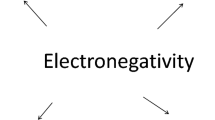Abstract
A widely used criterion for the existence of a noncovalent interaction is that the interatomic separation be less than the sum of the van der Waals radii of the respective atoms. However, this criterion should not be applied rigidly, but rather with considerable caution and flexibility, for several reasons. First, there is considerable uncertainty in the values assigned as van der Waals radii. Second, because of the manner in which they are assigned, their sums will necessarily miss a significant number of noncovalent interactions. Finally, not all interactions are between atoms; sometimes, instead of an atom, it is a region of positive or negative electrostatic potential that is involved.




Similar content being viewed by others
Data availability
See manuscript.
References
Stevens ED (1979). Mol Phys 37:27–45
Nyburg SC, Faerman CH (1985). Acta Cryst B41:274–279
Ikuta, S. J. Mol. Struct. (Theochem), 1990, 205, 191–201
Batsanov SS (2000). Struct Chem 11:177–183
Eramian H, Tian Y-H, Fox Z, Beneberu HZ, Kertesz MJ (2013). Phys Chem A 117:14184–14190
Politzer P, Murray JS, Clark T (2013). Phys Chem Chem Phys 15:11178–11189
Politzer P, Murray JS (2020). ChemPhysChem 21:579–588
Bondi A (1964). J Phys Chem 68:441–451
Rowland RS, Taylor RJ (1996). Phys Chem 100:7384–7391
Pauling L (1960) The nature of the chemical bond3rd edn. Cornell University Press, Ithaca, NY
Sanderson RT (1960) Chemical periodicity. Van Nostrand Reinhold, New York
Yang Z-Z, Davidson ER (1997). Internat J Quantum Chem 62:47–53
Badenhoop JK, Weinhold FAJ (1997). Chem Phys 107:5422–5432
Batsanov SS (2001). Inorg Mater 37:871–885
Alvarez S (2013). Dalton Trans 42:8617–8636
Dance I, New J (2003). Chem. 27:22–27
Politzer P, Murray JS, Lane P (2007). Internat. J. Quantum Chem. 107:3046–3052
Hellmann H (1937) Einführung in die Quantenchemie. Deuticke, Leipzig
Feynman RP (1939). Phys Rev 56:340–343
Hennemann M, Murray JS, Riley KE, Politzer P, Clark TJ (2012). Mol. Model. 18:2461–2469
Politzer P, Murray JS, Clark T (2015). J Mol Model 21:52
Clark T, Politzer P, Murray JS (2015). WIREs Comput Mol Sci 5:169–177
Clark T, Murray JS, Politzer P (2018). Phys Chem Chem Phys 20:30076–30082
Frisch, M. J.; Trucks, G. W.; Schlegel, H. B.; Scuseria, G. E.; Robb, M. A. et al, Gaussian 09, Revision A.1, Gaussian, Inc., Wallingford, CT, 2009
Bulat FA, Toro-Labbé A, Brinck T, Murray JS, Politzer PJ (2010). Mol Model 16:1679–1691
Politzer P, Murray JS, Clark T, Resnati G (2017). Phys Chem Chem Phys 19:32166–32178
Politzer P, Resnati G, Murray JS (2017). Faraday Disc 203:113–130
Politzer P, Murray JS (2019). Crystals 9:165
Nayak SK, Kumar V, Murray JS, Politzer P, Terraneo G, Pilati T, Metrangolo P, Resnati G (2017). CrystEngComm 19:4955–4959
Murray JS, Shields ZP-I, Seybold PG, Politzer PJ (2015). Comput Sci 10:209–216
Politzer P, Murray JS (2015). Cryst Growth Des 15:3767–3774
Politzer P, Murray JSJ (2018). Comput Chem 39:464–471
. Bent, H. A. Chem. Rev. 1968, 68, 587–648
Funding
P. Politzer and J. S. Murray.
Author information
Authors and Affiliations
Contributions
Calculations: J. S. Murray, 83.79%, and P. Politzer, 16.21%. Writing: J. S. Murray, 19.75%, and P. Politzer, 80.25%. Thinking: not applicable.
Corresponding author
Ethics declarations
Competing interests
None.
Ethical approval
None.
Consent to participate
Participation was consensual.
Consent to publish
Dependent upon journal.
Additional information
Publisher’s note
Springer Nature remains neutral with regard to jurisdictional claims in published maps and institutional affiliations.
Rights and permissions
About this article
Cite this article
Politzer, P., Murray, J.S. The use and misuse of van der Waals radii. Struct Chem 32, 623–629 (2021). https://doi.org/10.1007/s11224-020-01713-7
Received:
Accepted:
Published:
Issue Date:
DOI: https://doi.org/10.1007/s11224-020-01713-7




